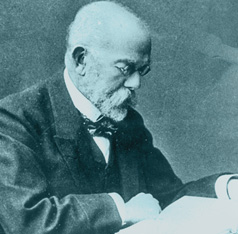About the Foundation
Alumni Symposium 2022
Alumni Symposium 2022
Robert Koch Postdoc Prize Awardees
Organizers
Christian Drosten, Mathias Hornef, Max Löhning, Andreas Radbruch,
Sabine Timmermann and Katrin Moser
Participants
Alumni of the Robert Koch Post-doctoral Award, Robert Koch Awardees 2022, Board
of Directors, Scientific Advisory Council Members, and Sponsor Representatives
Thursday, 10th of November 2022
Innate Immunity

Vaccination with the live-attenuated yellow fever virus vaccine strain (YF-17D) provides life-long protection against infection and is a unique model for studying the immune response to an acute self-limiting RNA virus infection in humans. To elucidate the early innate immune events which precede the rapid generation of adaptive immunity, we investigated the response of blood dendritic cell (DC) and monocyte subpopulations to YF-17D in vivo by high-dimensional flow cytometry and bulk RNA-sequencing before and at multiple timepoints after vaccination. We detected transient activation and upregulation of a common Interferon-stimulated gene signature in all DC and monocyte subsets on day 3 and 7 after vaccination as well as cell-type specific responses. Thus, the innate immune response to YF-17D vaccination is marked by concerted temporary activation of all circulating DC and monocyte subpopulations with distinct and overlapping gene expression programs. This well-coordinated innate response limits viral replication preventing vaccine-associated disease and is followed by rapid induction of protective antibody and T cell responses.
Frequencies and activation state of circulating DC and monocyte subsets were analyzed by flow cytometry in a cohort of hospitalized COVID-19 patients and in outpatients with a mild course of the disease. Compared to YF17D vaccination, patients with more severe COVID-19 showed low expression of costimulatory molecule CD86 in the cDC2, DC3 and monocytes. In contrast, non-hospitalized patients with mild COVID-19 showed an upregulation of CD86 similar to what was observed in YF17D vaccinees. The downregulation of CD86 in severe COVID-19 was accompanied by upregulation of PD-L1. This altered phenotype of peripheral APCs coincided with a reduced capability of DC3 and monocytes isolated from the blood of COVID-19 patients to co-stimulate autologous T cell activation and proliferation in vitro. An increase of Ki67+ DCs alongside temporary reductions in cDC1 and cDC2 frequencies indicated a higher turnover of the blood DC compartment in both COVID-19 patients and YF17D vaccinees. Profound longer lasting depletion of circulating DCs was a characteristic feature of severe COVID-19 while the reduction of blood DCs was transient after YF17D vaccination. Functional impairment and delayed regeneration of DCs and monocytes may have consequences for susceptibility to secondary infections and therapy of COVID-19 patients.

Enteroinvasive pathogens, such as Shigella and Salmonella, induce their uptake into non-phagocytic epithelial cells through the injection of effectors by the type-3-secretion system. The bacteria are ingested in tight bacterial-containing vacuoles (BCVs) that are surrounded by in situ formed infection-associated macropinosomes (IAMs). In contrast to previous reports, we have recently shown via novel 3D imaging techniques that macropinocytosis is not required for the entry of these bacterial pathogens, however the IAMs regulate their subsequent intracellular trafficking. In the case of Shigella, IAMs do not fuse with the BCV, and contact between these two compartments results in the destabilization of the BCV and membrane rupture. In the case of Salmonella two scenarios occur; IAMs either fuse with the BCV, which results in the generation of the Salmonella containing vacuole surrounded by Salmonella induced filaments (Sifs). Simple contact between IAMs and the BCV also promote vacuolar rupture in the case of Salmonella leading to cytoplasmic hyper-replication. Interestingly, BCV contacts with the surrounding compartments also dictates intravuolar bacterial growth or dormancy. We have performed ultra-structural studies, combined with dynamic imaging and proteomics of the involved compartments to identify the molecules that drive these complex interactions. This has shown a regulatoy network of Rab GTPases, the Exocyst complex, and SNAREs that is hijacked by injected bacterial effectors. I will describe how novel imaging technologies provide new insights into the intracellular niche formation of entero-invasive bacterial pathogens.

Inflammasomes are intracellular protein complexes that control proteolytic maturation
and secretion of inflammatory interleukin-1 (IL-1) family cytokines and are thus important in host defense. While some inflammasomes are activated simply by binding to pathogen-derived molecules, others, including those nucleated by NLRP3 and NLRP1, have more complex activation mechanisms that are not fully understood. We screened a library of small molecules to identify new inflammasome activators that might shed light on activation mechanisms. We find that clinical tyrosine kinase inhibitors (TKIs) including imatinib and masitinib activate the NLRP3 inflammasome. Mechanistically, these TKIs cause lysosomal swelling and damage, leading to cathepsin-mediated destabilization of myeloid cell membranes and cell lysis. This is accompanied by potassium (K+) efflux, which activates NLRP3. Both lytic cell death and NLRP3 activation but not lysosomal damage induced by TKIs are prevented by the cytoprotectant high molecular weight polyethylene glycol (PEG). Our study establishes a screening method that can be expanded for inflammasome research and immunostimulatory drug development, and provides new insight into immunological off-targets that may contribute to efficacy or adverse effects of certain TKIs.

Type I interferons (IFN-alpha/beta), cytokines that belong to the so-called innate immunity , are produced by cells as a first response to virus infection („IFN induction“). The secreted IFNs bind to their cognate receptor on neighbouring cells, and stimulate the expression of genes which have immunoregulatory or antiviral activity. The IFN system thus enables our body to rapidly sense virus infections, activate the immune response, and to form around the infection site a wall of cells that are in an antiviral state.
Intensive research of the last 20 years has enormously advanced our understanding of the IFN system. We now know that all nucleated cells express sensor proteins which are able to recognize virus-specific RNA structures and activate the signaling chain leading to IFN induction. However, it also got increasingly clear that viruses have evolved effective counterstrategies. Viral proteins, the so-called IFN antagonists, can disturb or even completely block all stages of the IFN response, e.g. IFN induction, IFN signaling, or expression or action of antiviral genes.
In our group, we investigate the interplay between IFN system and pathogenic RNA viruses, e.g. Rift Valley fever virus or SARS-coronaviruses. On one hand, we study how a cellular sensor protein can recognize an RNA structure as being viral, and on the other hand we are elucidating the astonishing variety of strategies by which viruses inhibit the IFN response. Insights obtained by such investigations can help to improve vaccines or antiviral therapies.

Human Cytomegalovirus (HCMV) infection causes only mild disease in immunocompetent individuals, but can cause severe complications in immunosuppressed individuals such as AIDS or transplant patients and is the major viral cause of birth defects. Our current understanding of immune control of HCMV infection is incomplete, and treatment options are limited. Type I interferons (IFNs) are potent cytokines which have long been considered as important effectors to rapidly counteract viral infection. Recent studies discovered a novel pathway for the innate immune defense during viral infection: the bone morphogenetic protein (BMP) signaling pathway [1]. Proteomic analyses indicated that HCMV may downregulate components of the BMP signaling machinery via the viral US18 and US20 proteins [2], suggesting deliberate manipulation of BMP-mediated signaling by HCMV due to its putative anti-viral effects. To assess the potential contribution of BMPs to control HCMV infection, we investigated whether BMPs inhibit HCMV replication and explored the effects of BMP stimulation on type I interferon (IFN) signaling and antiviral responses.
We found that pre-stimulation of primary human foreskin fibroblasts (HFF-1) with BMPs induces low levels of transcription of interferon-stimulated genes (ISGs), though without affecting HCMV replication. However, co-stimulation of HFF-1 with BMP9 and IFNβ prior to infection significantly enhanced the antiviral activity of IFNβ as compared to IFNβ pre-stimulation alone. Further experiments showed that BMP9 significantly enhances the phosphorylation of signal transducer and activator of transcription 1 (STAT1) and transcription of interferon regulatory factor 9 (IRF9) and STAT2, which are critical components of IFN-induced signaling. Moreover, we can show that HCMV US18 and US20 specifically antagonize BMP-mediated, but not IFN-mediated signaling, and their expression during HCMV infection impedes the responsiveness of HFF-1 to BMP9 stimulation, thus circumventing the potential effect of BMP9 on the antiviral host response to infection.
Taken together, our data reveal a previously underappreciated role of BMP9 as an important modulator of innate immunity and type I IFN signaling during HCMV infection.
[1] Eddowes et al., 2018, Nature Microbiology
[2] Fielding et al., 2018, eLife
Microbiology

The focus of my group's research is the interaction between commensal and pathogenic microorganisms with the mucosal immune system in the small intestine. In particular, we are interested in the situation of the neonate host that transits from the environmentally protected and sterile situation in utero to microbial and environmental exposure after birth on its way to establish a stable host-microbial homeostasis. This is reflected by many striking structural and functional differences between the neonate and adult intestinal epithelium and mucosal immune system.
Beside a better understanding the mutual interaction between commensal bacteria and the host we aim at identifying age-specific differences in the antimicrobial host response and susceptibility to infection with enteropathogenic microorganisms such as enteric Salmonella, enteropathogenic E. coli (EPEC), Listeria monocytogenes, rotavirus, and Giardia lamblia. These pathogens cause a very significant morbidity and – particularly in the infant population – also a significant mortality worldwide.
We hope that a better understanding of the feto-neonatal transition of the intestinal mucosa, the postnatal establishment of host-microbial homeostasis and the protective immune response to infection will contribute to reduce childhood mortality and reduce long-term sequelae.

We use urinary tract infection (UTI) and asymptomatic bacteriuria (ABU) as models to study the molecular mechanisms involved in different types of host-bacterium interaction leading to infection or colonization. Pathogens infect susceptible hosts and cause the immune system to react in an aggressive and self-damaging way, causing disease. Asymptomatic colonizers, on the other hand, successfully establish themselves in the host without provoking and harming it. During ABU, high bacterial numbers are present in the urinary bladder, without causing symptoms of UTI. It is not only interesting from the perspective of basic researchers to understand how symptomatic infections or asymptomatic colonizations arise. It is also exciting for applied research to find out how pathogens or asymptomatic colonizers interact with their hosts to search for new targets for therapy and prevention.
Bacterial adaptation strategies during long-term asymptomatic colonization include genomic decay and attenuation. In addition, the bacteria have also developed sophisticated mechanisms to actively manipulate the host in their favour. For example, asymptomatic bladder colonization of E. coli isolate 83972 can protect human carriers from superinfections by uropathogens. This strain actively modulates the host environment, down-regulating transcriptional activity, including that of pro-inflammatory genes. Uropathogenic E. coli can affect host gene expression by repressing the expression of key transcription factors in the host. At the level of chromatin dynamics, the host also responds differently to interaction with pathogens or asymptomatic colonizers. These observations point to previously unknown strategies for bacterium-host interaction at mucosal membranes, the underlying molecular mechanisms of which have not yet been fully elucidated.
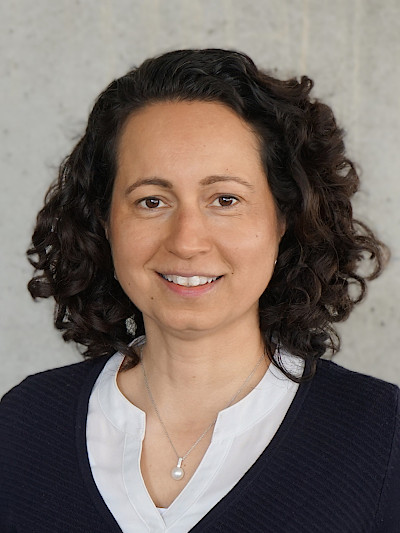
CRISPR-Cas systems are nowadays widely used for diverse biomedical and biotechnological applications, such as genome editing in eukaryotes. However, these systems are originally derived from prokaryotes, where they act as RNA-guided immune systems. An expanding diversity of such CRISPR-Cas systems in bacteria and archaea has been reported that protects them against invading nucleic acids, such as phages and plasmids. Here I will present, how we developed a new CRISPR-Cas9 based multiplexable RNA diagnostics platform, starting from a discovery that we made while studying biology of the CRISPR-Cas9 system in the food-borne pathogen Campylobacter jejuni [1].
During genome defense, CRISPR-Cas nucleases typically rely on CRISPR RNA (crRNA) guides encoded in repeat-spacer arrays associated with the system to recognize foreign genetic material. In Type II systems, another RNA component, the trans-activating crRNA (tracrRNA) hybridizes to the crRNAs to drive their processing and utilization by the Cas9 nuclease. While Cas9 typically binds and cleaves double-stranded DNA, we had uncovered that C. jejuni Cas9 (CjCas9) can also target endogenous RNAs in a crRNA-dependent manner based on a RIP-seq (co-immunoprecipitation combined with RNA-seq) approach [2]. While analyzing CjCas9-RNA complexes from additional C. jejuni strains, we recently discovered that the tracrRNA does not only bind to the crRNAs, but can also hybridize to certain cellular RNAs, such as mRNAs, leading to the formation of “non-canonical” crRNAs (ncrRNAs) [1]. While the function of these ncrRNAs in C. jejuni remains elusive, we demonstrated that these mRNA-derived fragments are capable of guiding DNA targeting by Cas9 in vitro and in vivo. Our discovery of ncrRNAs inspired the engineering of reprogrammed tracrRNAs that link the presence of any RNA-of-interest to DNA targeting with different Cas9 orthologs. This capability became the basis for a multiplexable diagnostic platform termed LEOPARD (Leveraging Engineered tracrRNAs and On-target DNAs for PArallel RNA Detection) [1]. LEOPARD can detect multiple RNAs of respiratory viruses in parallel and can distinguish different SARS-CoV-2 viral variants at single nucleotide resolution in patient samples. Overall, our study revealed crRNAs can originate from outside of CRISPR-Cas systems, and we have translated this finding into a multiplexable RNA detection platform.
References:
[1] Jiao C, Sharma S*, Dugar G*, Peeck NL, Bischler T, Wimmer F, Yu Y, Barquist L, Schoen C, Kurzai O, Sharma CM#, Beisel CL# (2021) Non-canonical crRNAs derived from host transcripts enable multiplexable RNA detection by Cas9. Science, (6545):941-948. *Equal contribution, #Corresponding authors
[2] Dugar G, Leenay RT, Eisenbart SK, Bischler T, Aul BU, Beisel CL#, Sharma CM# (2018). CRISPR RNA-Dependent Binding and Cleavage of Endogenous RNAs by the Campylobacter jejuni Cas9. Molecular Cell 69, 893–905.
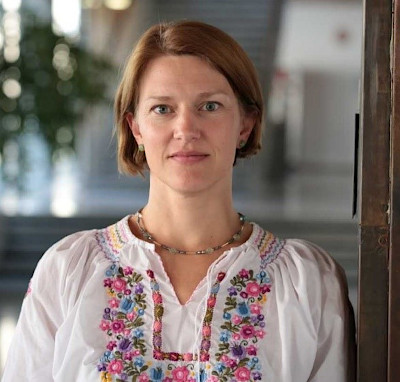
The mammalian gastrointestinal tract is a highly dynamic microbial ecosystem that controls its hosts health through its collective behavior. Microbial communities harbor hundreds of bacteria that form complex metabolic networks. Efficient metabolic interactions are essential for dietary breakdown, production of bioactive metabolites and pathogen exclusion. The lack of suitable model systems has limited our current understanding of the role of individual community members in host-microbiota interactions and resistance to infections. In my lab, we use synthetic bacterial communities that we can study in silico, in vitro and in gnotobiotic mouse models. We now understand, how individual strains within a bacterial consortium interact to influence complex microbiome functions such as colonization resistance to bacterial infections and provide necessary insight to develop strategies to steer microbial communities towards beneficial interactions promoting human health.
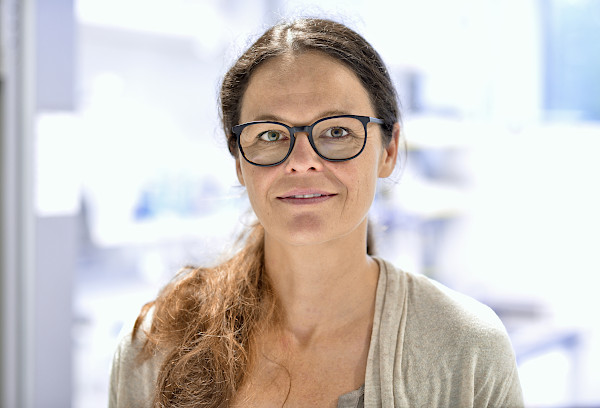
The bacterial cell wall biosynthetic network is a very effective target for antibiotics. A most prominent target within the peptidoglycan biosynthesis pathway is the cell wall building block lipid II, which represents a particular “Achilles heel” for antibiotic attack. Lipid II is a unique non-protein target which is one of the structurally most conserved molecules in bacterial cells.
Nature invented a variety of different „lipid II binders“ and their antibiotic activities can vary substantially depending on the compounds physicochemical and membrane-targeting properties, the binding site on lipid II, as well as the ability to interact with structurally similar precursors of other cell wall polymers, such as wall teichoic acid, capsule or arabinogalactan.
Besides the primary contact events, which result from initial drug-target interaction and direct binding of lipid II, sequestration of the ultimate cell wall building block can trigger multifaceted cellular events that all contribute to killing. These secondary events originate from the unique cellular role of lipid II, functioning as a structural and regulatory focus that directly and/or indirectly contributes to the organization of diverse cell wall biosynthetic processes.
The most recent addition to the portfolio of lipid II binding natural product antibiotics are teixobactin and newly identified teixobactin-like antibiotics (TLA), isolated from previously uncultured soil bacteria. Compared to all other lipid II binders investigated previously, teixobactin and TLAs appear unique in their mechanism of action and proved most refractory to resistance development.
H. pylori infection is linked to gastric diseases such as ulcers and cancer. We have identified that H. pylori not only colonize the stomach mucus but also invade deep into gastric glands, where they can directly interact with long-lived stem cells. I will elaborate on our recent findings that suggest that these gland-associated bacteria are key drivers of gastric inflammation and epithelial pathology.
Adaptive Immunity

The maintenance of the gut physiology depends largely on the immune regulatory network constantly rebalancing tissue homeostasis. The ability of regulatory T cells (Tregs) to home and expand in inflamed intestinal tissues and limit local damage is one of the most important features of this homeostatic network. However, the same regulatory mechanisms are also engaged in response to tissue remodeling and inflammation in the setting of a growing tumor. This in turn contributes to tumor immune evasion and resistance to immunotherapy. Therefore, targeting Tregs is an attractive strategy for cancer immunotherapy to restore and promote antitumor immune responses and potentially limit immune resistance. Given the contradictory role of Tregs in the gut, insights into specific features and the localization of tumor-associated Tregs are of high importance, when considering targeted antitumor therapies. Using a murine model of inflammation-induced colorectal cancer, we demonstrated that tumor-associated Tregs are mainly of thymic origin, inhibit antitumor immunity and are equipped with a specific set of molecules strongly associated with enhanced migratory properties. Particularly, a dense infiltration of Tregs in mouse and human colorectal cancer lesions correlated with increased expression of the orphan chemoattractant receptor GPR15. Interestingly, GPR15 expression was associated with elevated IL17 and TNF-α secretion, cytokines that are critical components of the inflammatory process involved in colorectal carcinogenesis. Gpr15 deficiency repressed Treg infiltration in colorectal cancer, which paved the way for enhanced antitumoral T-cell immunity and reduced tumorigenesis. Thus, it will be important to determine the extent to which GPR15+ Tregs contribute to colorectal cancer through the release of proinflammatory cytokines, the suppression of antitumor immune responses, or both mechanisms. In summary, our study underscore the relevance of the Treg migratory profile in supporting tumor development and progression and suggests GPR15 as a promising novel target for modifying T-cell-mediated antitumoral immunity in colorectal cancer.

As indicated by the success against SARS-CoV-2, Ebola virus, or RSV, monoclonal neutralizing antibodies have a remarkable potential for the use in treatment and prevention of viral infections. However, pre-existing or de novo escape and viral diversity pose considerable challenges to antibody-mediated strategies. Focusing on antibodies targeting HIV-1 and SARS-CoV-2, preclinical and clinical advances in neutralizing antibodies and strategies for their effective application will be discussed.

In this talk, the role of the alarmin IL-33 and its receptor in the activation and differentiation of antiviral effector and memory T cells will be addressed. A second focus will be on the stability and plasticity of memory T helper cell subsets in immune responses to viruses.

Upon antigen encounter, individual T-cell clones are recruited into the immune response, clonally expand and differentiate into effector and memory subsets. This evolutionary process of adaptation to an antigen called clonal selection is a hallmark of the adaptive immune response. Surprisingly little is known about the functionality of antigen-specific T-cell clonotypes that are recruited into immune responses in vivo, particularly in humans. In this talk I will outline past and ongoing efforts to delineate T cell receptor-driven fate of pathogen antigen-specific T cell responses, which may guide the development of enhanced future vaccines and instruct our understanding of human T-cell biology.

Natural Killer (NK) cells eliminate infected and tumor cells by releasing cytotoxic granules containing perforin and granzymes or by engaging death receptors that initiate caspase cascades. One NK cell can kill multiple target cells in a serial fashion. However, the orchestrated interplay between the cell death pathways remains poorly defined. Additionally, it is unclear which granzymes are used by NK cells to eliminate target cells. We used fluorescent localization reporters to simultaneously measure the activities of different granzymes or caspase-8 in tumor cells upon contact with human NK cells by live cell imaging.
We observed rapid GrzB-induced target cell death, originating from early established
NK:target contacts. In contrast, cell death mediated by caspase-8 was slower and a result of late target cell engagements. This suggested a kinetic regulation of the two cytotoxic pathways during serial killing. We observed that NK cells switch from inducing GrzB-mediated cell death in their first killing events to a death receptor-mediated killing during subsequent tumor cell encounters. Investigating the use of the different granzymes we found that GrzB dominated most killing events of freshly isolated or activated human NK cells, while we also detected the activity of other granzymes. GrzK initiated target cell apoptosis was limited to freshly isolated NK cells. Additionally, we found individual killing events of activated NK cells where GrzA or GrzM activity was dominant. This demonstrates that granzyme and death receptor-mediated cytotoxicity are differentially regulated during NK cell serial killing.
Friday, 11th of November 2022
Virology, part 1
The reconstruction of functional changes during virus emergence has become a major interest in evolutionary virology. The somewhat imprecise concept of “emergence” is used to capture the diverse changes that occur in zoonotic viruses while they are selected from diverse populations existing in animal reservoirs, adapt to new host environments such as in humans, and evade mounting population immunity in the case of sustained transmission. This contribution will present examples of evolution during coronavirus (CoV) emergence. During 2014/15, the MERS-CoV has increased its fitness even while still in the animal reservoir, camels, undergoing a change in innate immunity evasion that is effective in human cells. After host change, it is expected that a zoonotic virus adapts to the new host. However, for SARS-CoV the early human-to-human transmission chain involved a case of gene and function loss, providing a textbook example of neutral evolution. For SARS-CoV-2, adaptive functional changes occurred in humans even before establishment of wide antibody immunity, probably linked to the acquisition of prolonged infection stability in mucosal fluid environment. Studies of individual mutations in full SARS-CoV-2 background show that viral replicative fitness and antibody neutralization escape are separable functional traits that underwent mutual adjustments during evolution.

The coronavirus disease 2019 (COVID-19) pandemic claimed almost 20 million lives in 2020-2021 and continues to strain health systems and economies. Vaccines are the premier option to contain the pandemic but this approach is undermined by the constant emergence of SARS-CoV-2 variants that evade neutralizing antibodies. The research in my laboratory is focused on antibody evasion and host cell entry of emerging SARS-CoV-2 variants. I will present evidence that the Omicron subvariant BA.5, which is globally dominating at present, efficiently evades antibodies and, unlike previously circulating Omicron subvariants, robustly enters lung cells and replicates in lung tissue. Thus, BA.5 may have lost a restriction that is believed to be at least partially responsible for the attenuation of the Omicron variant. Further, data on antibody evasion of emerging variants that currently outcompete BA.5 will be presented and it will be discussed how changes in the entry strategy can promote antibody evasion.

Next generation sequencing has revealed the presence of numerous RNA viruses in animal reservoir hosts, including many closely related to known human pathogens. Despite their zoonotic potential, most of these viruses remain understudied due to not yet being cultured. While reverse genetic systems can facilitate virus rescue, this is often hindered by missing viral genome ends. A prime example is Lloviu virus (LLOV), a newly discovered filovirus circulating in bats in Europe that is closely related to the highly pathogenic Ebola virus. Using reverse genetics systems, we complemented the missing LLOV genomic ends and identified cis-acting elements required for LLOV replication that were lacking in the published sequence. We leveraged these data to generate recombinant full-length LLOV clones and rescue infectious virus. Similar to other filoviruses, recombinant LLOV (rLLOV) forms filamentous virions and induces the formation of characteristic inclusions in the cytoplasm of the infected cells, as shown by electron microscopy. Known target cells of Ebola virus, including macrophages and hepatocytes, are permissive to rLLOV infection, suggesting that humans could be potential hosts. However, inflammatory responses in human macrophages, a hallmark of Ebola virus disease, are not induced by rLLOV. Additional tropism testing identified pneumocytes as capable of robust rLLOV and Ebola virus infection. We also used rLLOV to test antivirals targeting multiple facets of the replication cycle. Rescue of uncultured viruses of pathogenic concern represents a valuable tool in our arsenal for pandemic preparedness.

Flaviviruses pose a constant threat to emerge as epidemics or pandemics. As such, Dengue virus (DENV) is one of the world’s fastest-growing infectious diseases. Using a FRET-based screening for capsid multimerization inhibitors, we identified a compound (C10) that shows excellent antiviral activity against Flaviviridae family members including HCV, DENV, West-Nile virus (WNV), Zika virus (ZIKV), Yellow-Fever virus (YFV) and Tick-borne encephalitis virus. In cell-based assays, C10 was non-cytotoxic at concentrations >100-fold higher than the IC50 (CC50>50µM; IC50=10-150nM). Since C10 was screened to bind and interfere with proper self-interaction of the flavivirus capsid protein, we hypothesized that the broad activity of C10 against Flaviviridae depends on structural similarities within flaviviral nucleocapsids.
In vitro experiments using recombinant HCV and DENV capsid protein showed the ability of C10 to establish a covalent interaction, inducing the formation of dimers, trimers, and higher molecular weight species. These oligomers formed at concentrations below the IC50, and the effect increased in a dose-dependent manner.
By structure-activity-relationship studies, a set of 45 C10-derivatives were designed, synthesized, and tested against HCV as well as DENV. In parallel, all compounds were evaluated in crosslinking assays. As a result, we observed a high correlation between the crosslinking ability of each compound and its activity in the cell-based assay. The activity and toxicity of C10 and two selected hit candidates (C45 and C46) were further characterized. IC50 values for different stages of HCV and DENV infection, as well as CC50 values, were determined. The calculated therapeutic index (Ti) showed that C45 is ~3-4 times better than C10 (Ti~330 HCV, ~870 DENV), being both very promising antiviral compounds. Moreover, toxicity of C10 and C45 were tested in vivo including zebrafish and mouse models, where different pharmacological parameters were evaluated. Finally, in vivo efficacy is tested in Flavivirus-infected mice. Altogether, C10 and C45 are promising molecules for further development as antiviral agents against virtually all members of the Flaviviridae family.

The COVID-19 pandemic still raises the need for improved antiviral treatment, preferably using drugs that are already in clinical use for different purposes. Besides virus-neutralizing nanobodies (Güttler et al., EMBO J 2021), we tested inhibition of nucleotide synthesis as a strategy to decrease the replication of viral RNA, thus diminishing the formation of virus progeny.
Methotrexate (MTX) has been used over decades for immunosuppression and cancer therapy. The drug inhibits dihydrofolate reductase and other enzymes required for the synthesis of nucleobases. Strikingly, the replication of SARS-CoV-2 was inhibited by MTX in therapeutically achievable concentrations, leading to up to 1000-fold reductions in virus progeny (Stegmann, Dickmanns et al., Virus Res 2021)
Inhibitors of Dihydroorotate dehydrogenase (DHODH) are in clinical use for similar purposes as MTX, and they interfere with the synthesis of pyrimidines. Our investigations revealed that DHODH inhibitors also reduce the replication of SARS-CoV-2. Moreover, these compounds strongly synergize with N4-Hydroxy-Cytidine, the active compound of the antiviral drug Molnupiravir (NHC). Mechanistically, inhibiting DHODH induces a lack of available pyrimidines, thus increasing the incorporation of NHC. The drugs also cooperated to alleviate COVID in animal models (Stegmann, Dickmanns et al., iScience 2022). We are now targeting CTP-Synthetase to further increase the efficacy of NHC and Molnupiravir. As an important caveat, however, we also found that NHC strongly enhances the occurrence of virus mutants, including escapers from neutralizing nanobodies.
Using inhibitors of nucleotide synthesis for treating SARS-CoV-2 infections still needs to be evaluated clinically, and the role of immunosuppression in disease progression awaits clarification. Within these limitations, however, our results are at least compatible with a possible use of such inhibitors in treating COVID-19. The seminar will raise the perspective of re-purposing cancer drugs to antagonize the spread of SARS-CoV-2.
Virology, part 2

Recent progress has provided clear evidence that many RNA viruses form cytoplasmic biomolecular condensates mediated by liquid-liquid phase separation to form membrane-less compartments and facilitate their replication. In contrast, seemingly contradictory data exist for some DNA viruses, which replicate their DNA genomes in nuclear membrane-less replication compartments (RCs). Here, I will review the concept of liquid-liquid phase separation and elucidate the potential roles it plays in compartmentalizing viral replication. I will discuss the differences between the different virus groups in regard to condensate formation and propose a model of how liquid and homogenous early RCs convert into more heterogeneous RCs with complex properties over the course of infection.

The majority of emerging viruses posing a threat to human health are RNA viruses, which replicate their genomes in the cytoplasm. To protect the RNA genome from recognition by the innate immune system, RNA viruses evolved intricate mechanisms to re-shape cellular membranes into shielded replication compartments. Chikungunya virus, which causes debilitating arthritis, replicates in spherules at the plasma membrane. While the viral proteins involved in neck formation of spherules are well defined, host components remained elusive.
We found that the human tetraspanin CD81 is a critical replication factor for Chikungunya virus in fibroblasts and hepatocytes, two major replication sites of the virus. CD81 co-localizes with virus replication sites at the plasma membrane. The protein is dispensable for virus entry and release and is thus a bona fide replication factor. The closely related tetraspanin CD9 can partially replace the function of CD81 in virus replication. Murine CD81 similar to human CD81 supports virus genome replication, indicating that CD81 may be a cross-species host factor for Chikungunya virus. CD81 is known to stabilize membrane microdomains through cholesterol binding. By mutating the cholesterol binding site of CD81, we could show that cholesterol binding is critical for the host factor function of CD81. Finally, we show that human pathogenic viruses from the same family also rely on CD81 for replication. Our work identifies the first human transmembrane protein hijacked by Chikungunya virus for its replication. We propose a model by which CD81 supports the formation of virus replication organelles through its cholesterol binding function. This work will spur future studies defining the minimum requirements for virus replication in human cells and may reveal targets for antiviral therapies.

The establishment of latency allows herpesviruses to persist in the host for life. The dogma has been that all herpesviruses maintain their genome as a circular episome. However, several herpesviruses have recently been shown to integrate their genome into telomeres of latently infected cells. Among these are human herpesvirus 6A (HHV-6A), 6B (HHV-6B) and the highly oncogenic Marek’s disease virus (MDV) that maintain their integrated virus genome in the absence of episomal DNA. Integration of HHV-6A/B also occurs in germ cells, resulting in individuals that harbor the integrated virus genome in every single cell of their body and transmit it to their offspring. This condition has been termed inherited chromosomally integrated HHV-6 (iciHHV-6). About 1% of the human population have this condition, while the biological and medical consequences for these individuals remain poorly understood. This presentation will highlight our recent advances in understanding herpesvirus integration and its role in pathogenesis.
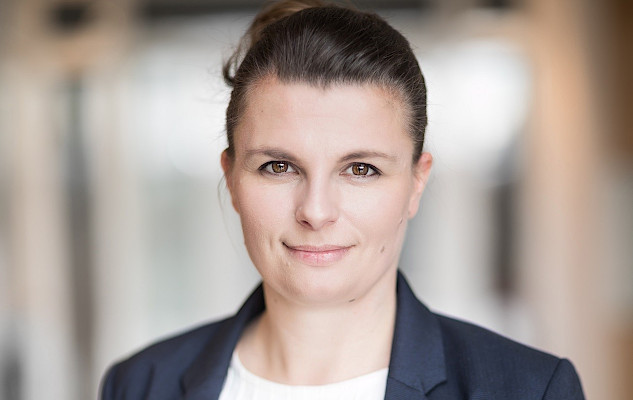
Cell-intrinsic innate immunity shapes the susceptibility and permissiveness of CD4+ T-cells to HIV-1 infection, and instructs the mounting of adaptive immune responses that can partially control HIV-1 replication. Vice versa, HIV-1 has evolved strategies to bypass or counteract these cellular defense mechanisms. Most of this knowledge has been gained in models of acute infection. The contribution of innate immunity to the establishment, maintenance and reversal of latency has not been adequately explored or is still under debate. However, cell-intrinsic immunity and its modulation by HIV-1 may exert a pivotal role in yet-to-be-developed strategies to effectively eliminate the replication-competent HIV-1 reservoir and thus functionally cure HIV-1/AIDS.
Here, by transcriptomics and functional analysis of CD4+ T-cells from aviremic patients with HIV-1 and immortalized T-cell models of HIV-1 latency, we studied the impact of latency-reverting agents (LRAs) on the cellular milieu and viral reactivation. Our work reveals quantitative and qualitative heterogeneity of individual provirus-containing clones in terms of HIV-1 reactivation. Furthermore, selected LRAs used in the context of pharmacological “shock-and-kill” approaches modulate cell-intrinsic responses by impairing both basal and IFN-induced expression of the majority of IFN-stimulated genes, resulting in facilitated HIV-1 reactivation. However, this LRA-induced reprogramming may hamper cellular processes driving immune recognition and killing of reactivating cells. Finally, identification and analysis of individual, HIV-1 transcript-positive CD4+ T-cells enabled us to define a set of genes whose expression correlated with HIV-1 RNA abundance, representing yet-to-be-characterized potential biomarkers of HIV-1 transcriptional reactivation.




